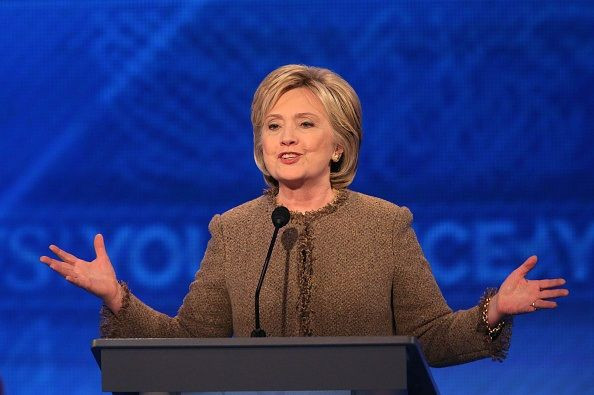Campaign 2016: Hillary Clinton Understates Her Wall Street Donations At Democratic Debate

In the Democratic debate Saturday evening, Hillary Clinton disputed that Wall Street is bankrolling her campaign, and she urged voters to check a website that she said proved her assertions. There was just one problem — her own statements at the debate and on the campaign trail suggest she hasn't closely studied what that website actually says about her own campaign finances.
Responding to Vermont Sen. Bernie Sanders’ charge that she’s a friend to the financial industry, Clinton said that only “about 3 percent of my donations come from people in the finance and investment world” — and she encouraged voters to “go to opensecrets.org and check that.”
But a review of Clinton’s campaign finances at that website shows she has raised significantly more money from companies that opensecrets.org, officially known as the Center for Responsive Politics (CRP), categorizes as part of the financial industry.
Contributions from persons employed by securities and investment firms represent roughly $2 million, or 2.6 percent, of the total $77 million raised by Clinton’s campaign. But CRP also classifies real estate firms, commercial banks and miscellaneous finance companies as part of the financial industry, according to Anna Massoglia, a researcher at the nonprofit organization.
That means Clinton has raised at least $5.2 million, or 6.7 percent of her campaign cash, from individuals working in what CRP defines as the financial industry — double the percentage she cited in the debate. By comparison, her rivals for the Democratic presidential nomination, Sanders and former Maryland Gov. Martin O’Malley, have respectively raised $200,678 and $262,650 from those industries, according to CRP data.
Clinton was apparently referring to money donated directly to her campaign; those numbers don’t account for the money raised by super PACs supporting her presidential run. Outside groups that back Clinton have pulled in almost $4 million, or 19 percent of their funds, from the financial industry, according to CRP data. Taken together, Clinton’s campaign and outside groups supporting her have raised 9.3 percent of their resources from the financial sector.
Clinton’s seeming lack of awareness of her own campaign finances has become something of a recurring theme: Earlier this week, she asserted that she did not know if she had ever accepted money from the fossil fuel industry. In fact, Clinton had periodically been among Congress’s top recipients of campaign cash from those connected to the oil and gas industry — and lobbyists who have represented fossil fuel firms are among her biggest fundraising bundlers in the 2016 election.
During the Saturday debate Clinton also said, “I have more donations from students and teachers than I do from people associated with Wall Street.” According to CRP, Clinton’s campaign has received $88,000 more from securities and investment professionals than those working in the education industry. (Clinton’s campaign does not itemize donations under $200.) And as fivethirtyeight.com pointed out, there are millions more students and teachers in the U.S. than there are New York City bankers.
There are 20 million college students in the U.S. and 3 million teachers, compared to 450,000 NYC finance jobs: https://t.co/pqXtKZeJc1
— FiveThirtyEight (@FiveThirtyEight) December 20, 2015© Copyright IBTimes 2024. All rights reserved.






















